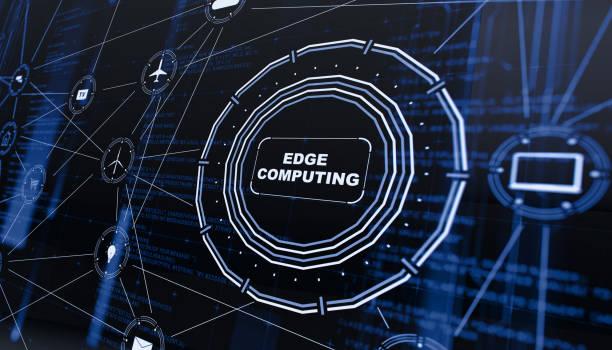Edge computing represents the fourth major paradigm shift in modern computing. The mainframes of the 1950s and ’60s were the first, followed by the shift to the client/server model of the ’70s and ’80s, a model that lasted well into the early 2000s. The cloud was the third major shift, a development pioneered by Amazon’s AWS. Now, edge computing has the potential to be as disruptive to how we share information as the cloud was to the client/server model.
Edge Computing is transitioning networks from being primarily data highways back and forth from a central location such as a cloud database, to a visual depiction of a spider’s web of interconnected, intermediate storage and processing devices. Enabling data from connected devices to be processed and analyzed closer to it’s point of origin, in terms of physical distance. Typically on an edge server or gateway located on the ‘edge’ of the network rather than a distant cloud server or corporate data center.
Richard Villars, Vice President, Data Center and Cloud at IDC says that IT at the edge is about the consumption of IT resources in increasingly ‘smart’ edge locations. These are the urban cores, hospitals, factories, transportation hubs, and a wide range of spaces where we all work, play, and live as well as where we all want to use ‘smart’ things to deliver optimal digital experience.
Transforming the healthcare sector?
According to the research article ‘The cutting edge of healthcare: How edge computing will transform medicine‘ By Computerworld, Many health IT Experts predict that the proximity of computing and storage capabilities of Edge Computing, will transform healthcare by delivering near-instantaneous data processing. Edge could support advanced remote-patient monitoring by processing data from medical devices such as blood pressure cuffs and then alerting clinicians to problematic readings. Allowing for real-time management of medical equipment throughout the hospital premises
“Edge is in the early phases of application in healthcare, but it’s something we’re looking at..”
John Henderson, CIO, Children’s Health of Orange County
The healthcare sector which is rapidly adopting to machine learning, AI, Robotics among other technologies, all which requires significant real-time data processing capabilities for effective delivery in a healthcare setting. With Edge Computing, the healthcare sector has a greater potential for better patient-care as healthcare experts say that this proximity of processing power is needed due to the high costs of moving large volumes of data to the cloud, networking limitations, and latency concerns.
Growth in other sectors
According to the Heavy Reading 2022 5G Network Strategies Operator Survey, current edge deployments are being driven by the healthcare, financial services and manufacturing industries. Heavy Reading says the next largest growth segment will be the media and entertainment sector, with 66% of respondents indicating they would deploy 5G edge services to these verticals in the next two years.
As the compiled data illustrates, the initial edge focus for service providers is to lower costs and increase performance. From a financial perspective, the main driver cited by 63% of those surveyed was to reduce bandwidth use and cost, followed by better support for vertical industry applications (46%) and differentiated services versus the competition (43%).
Two key criteria for edge deployments by smaller operators (less than $5bn in annual revenue) were improved resilience and application performance. Respondents cited that both these criteria had the effect of lowering costs and increasing customer satisfaction as service level agreements (SLAs) would be easier to fulfill.
From a financial perspective, the main driver cited by 63% of those surveyed was to reduce bandwidth use and cost, followed by better support for vertical industry applications (46%) and differentiated services versus the competition (43%)
Larger operators bring focus to differentiated services and applications that would create new revenues. The reason higher significance was communicated compared to smaller operators (68% versus 28%) might be centered in the need to compete not only with other telco service providers, but also hyperscalers. This presents an interesting observation considering that some service providers are looking to partner with hyperscalers to overcome challenges with edge deployment (Redhat Blog, 5G edge and security deployment evolution, trends and insights)
Advantages of Edge Computing:
- Real-time data processing & analyzing;
- Reduced distance between the origin points of data and the data storage (i.e: cloud), reduces the latency between data transfers and enables for real-time data processing.
- Lower costs;
- Infrastructure costs for Edge computing are lower than the costs required for a cloud or data center.
- Eliminating the possibility of a single point of failure;
- By utilizing multiple edge gateways or servers rather than a centralized cloud server or a corporate data center, the potential to lose access to the entire database due to a faulty cloud server is eliminated.
In 2016, Salesforce.com went offline for more than 24 hours due to an outage at Salesforce’s North American 14 site (aka NA14). Clients could not access troves of customer data, from phone numbers to emails, and more — which heavily disrupted business. Thus is the major problem with relying solely on a cloud (CBInsights)
Where Mbiz can help
Edge is the way to go for all businesses as it expands opportunities and migrating towards the use of edge computing is a critical direction for enterprises.
As a Redhat Technology partner in the OpenShift Container Platform, MBiz is your partner for Edge Computing Solutions.

